There have been some surprising narratives unfolding already in the EFL Championship so far this season. None more so than Coventry City’s rise to the top as the Sky Blues sit in fourth place in the table.
Four and a half years ago, former Manchester United and Manchester City striker Mark Robins took charge of Coventry and managed to take the club from League Two all the way to the Championship where they now look ready to fight for a play-off spot this season.
It would be a truly remarkable story if Robins managed to gain promotion to the Premier League with this Coventry team, although there is still a long way to go in the season so nothing can be certain as of now.
However, what is certain is that the Sky Blues are one of the best teams in England’s second-tier from a tactical perspective, playing a back three formation for the majority of the campaign so far.
This article will be a tactical analysis of Coventry City in the form of a team scout report. It will be an analysis of the tactics used by Robins’ side in and out of possession.
Formations, lineups, and summer recruitment
Last season, Coventry’s most used formation was a 3-4-1-2 and the unconventional system was deployed in 28 percent of the Sky Blues matches. However, a plethora of other formations were used too.
This season though, the 3-4-1-2 has been the most frequently used formation by far and Robins has set his side up in the shape in 71 percent of their matches so far in all competitions.
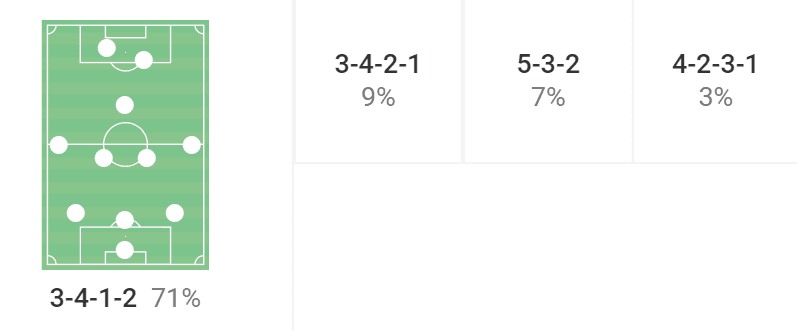
Robins wants his team to be expansive in possession and Coventry do look to play their way out from the backline in a possession-direct hybrid style of play. To do so, the centre-backs need to be comfortable on the ball.
Jake Clarke-Salter was brought into the club on a loan deal from Chelsea during the summer transfer window to partner alongside Kyle McFadzean and Dominic Hyam, two centre-backs that are very comfortable in possession, particularly the latter.
Simon Moore was brought to the Coventry Building Society Arena in the summer too as Robins looked to add quality to the goalkeeper department.
Two new wingbacks were also signed. 19-year-old prospect Ian Maatsen was loaned in from Chelsea like Clarke-Salter while Todd Kane was bought from Queens Park Rangers. The pair have been very important along with Fankaty Dabo as the manager rotates between the three players for the wingback positions.
One important aspect of Coventry’s wonderful form in this campaign is the consistency of Robins’ team selections. Using the 3-4-1-2, barring one or two minor personnel changes per game, the 51-year-old tends to select the same starting eleven.
Here is a lineup comprising of Coventry City’s most used players this season in the 3-4-1-2:

Ben Sheaf was purchased from Arsenal for an undisclosed fee and has been a really astute acquisition by the board. Sheaf generally partners alongside Gustavo Hamer although Jamie Allen and Liam Kelly have played in the double-pivot too.
Further forward, Callum O’Hare has been vital, once again, for the Sky Blues this season as the playmaker is currently averaging 2.3 key passes per 90.
What was important for Robins and the recruitment staff in the summer transfer market was to ensure that there were players ahead of O’Hare that were capable of scoring goals. Victor Gyökeres was signed permanently for an undisclosed fee while the experienced Martyn Waghorn was also brought in on a free transfer.
Both men are capable of running the channels, latching onto long balls in behind, and are very physical players so their teammates can play to feet or to their head when the situation requires it.
The 3-4-1-2 certainly gets the most out of the squad at Robins’ disposal and so the full credit to the manager for implementing a style within a framework that works best for his players.
Progressing play from deeper areas
In the build-up phase of the attack, Coventry’s central defenders push very wide with the wingbacks advancing higher up the pitch, holding the width on the flanks. The double-pivot sits behind the opposition’s first line of pressure and so this creates a 3v2 build-up structure.
When one of the wide centre-backs receives the ball, the ball-near wingback will drop shorter to become a closer passing option which helps the Sky Blues to circulate possession around while trying to find a way to break the first line of the opponent.
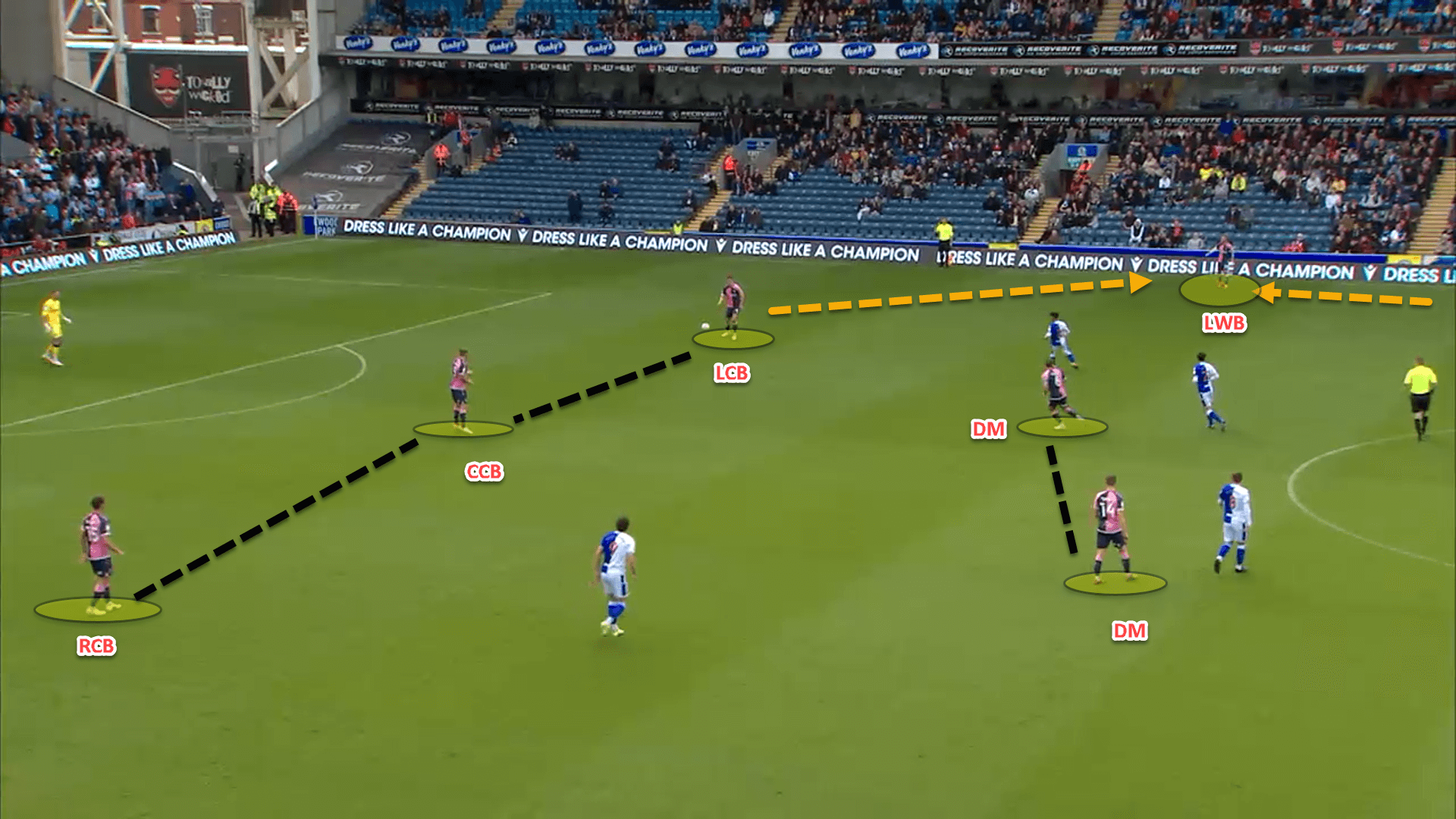
Here, Coventry’s double-pivot are being tightly marked and so the left-wingback drops to receive on the flank, providing the wide centre-back with a better passing option than risking playing inside.
Coventry like to break the opposition down through the central areas where plausible. Many teams like to attack down the flanks for a number of reasons. Firstly, teams can create wide overloads in the wide areas in order to play to the far side of the pitch and get a wide player in a 1v1 situation.
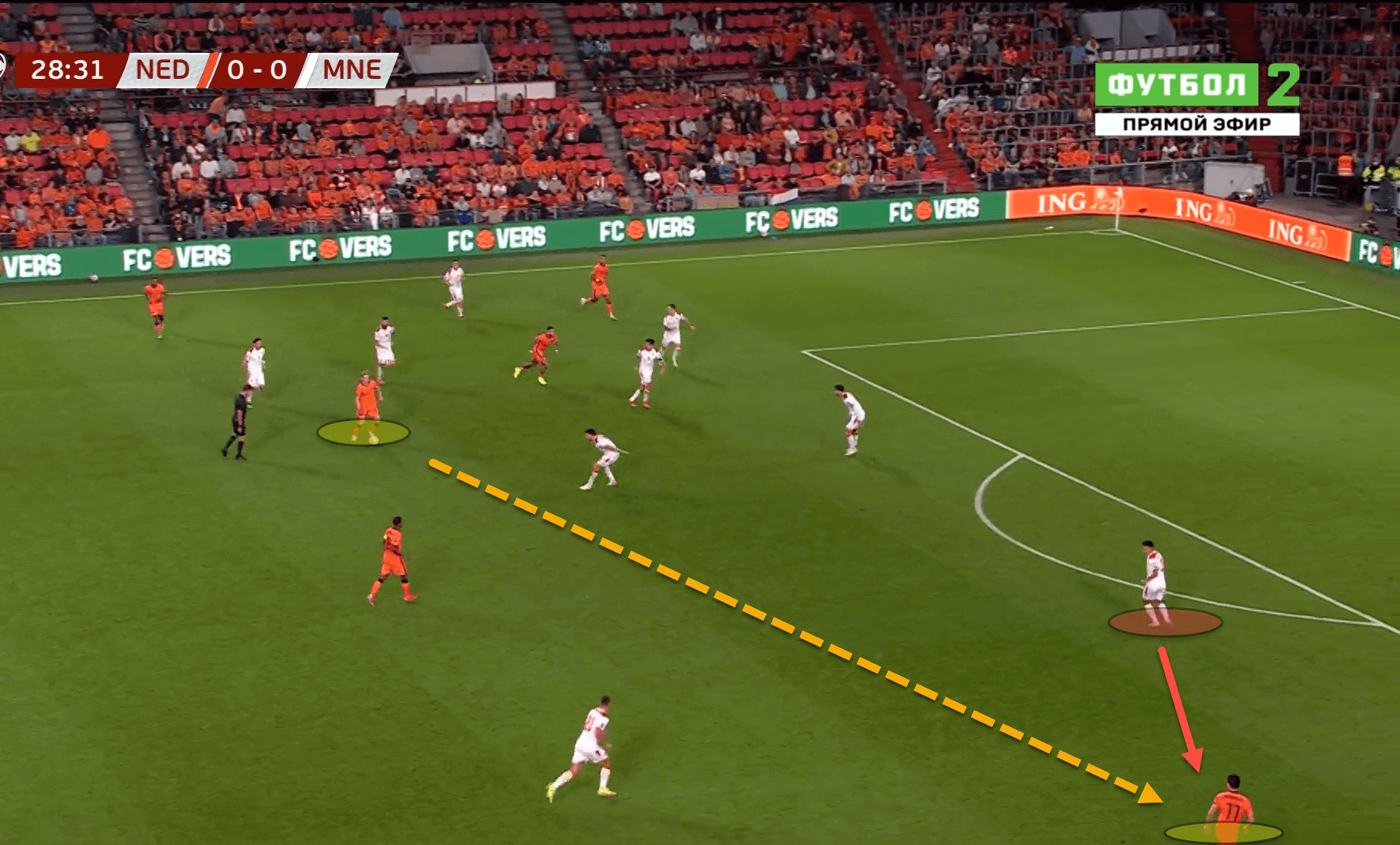
In this example, the Netherlands have created a wide overload on the left flank. The opposition have pushed their defensive block across in order to ensure that they have enough bodies to defend against the overload, which in turn leaves a wide player in a 1v1 situation with the defending fullback on his side.
Secondly, playing out wide helps teams cope with defensive transitions if they lose possession of the ball because they can use the touchline as an extra defender.
However, while Coventry do attack down the flanks, the objective is always to do so with the intention of playing further forward. One of the ways Robins has instructed his side to do this is by allowing Hyam to advance up the pitch almost as an auxiliary fullback in the attacking phase.
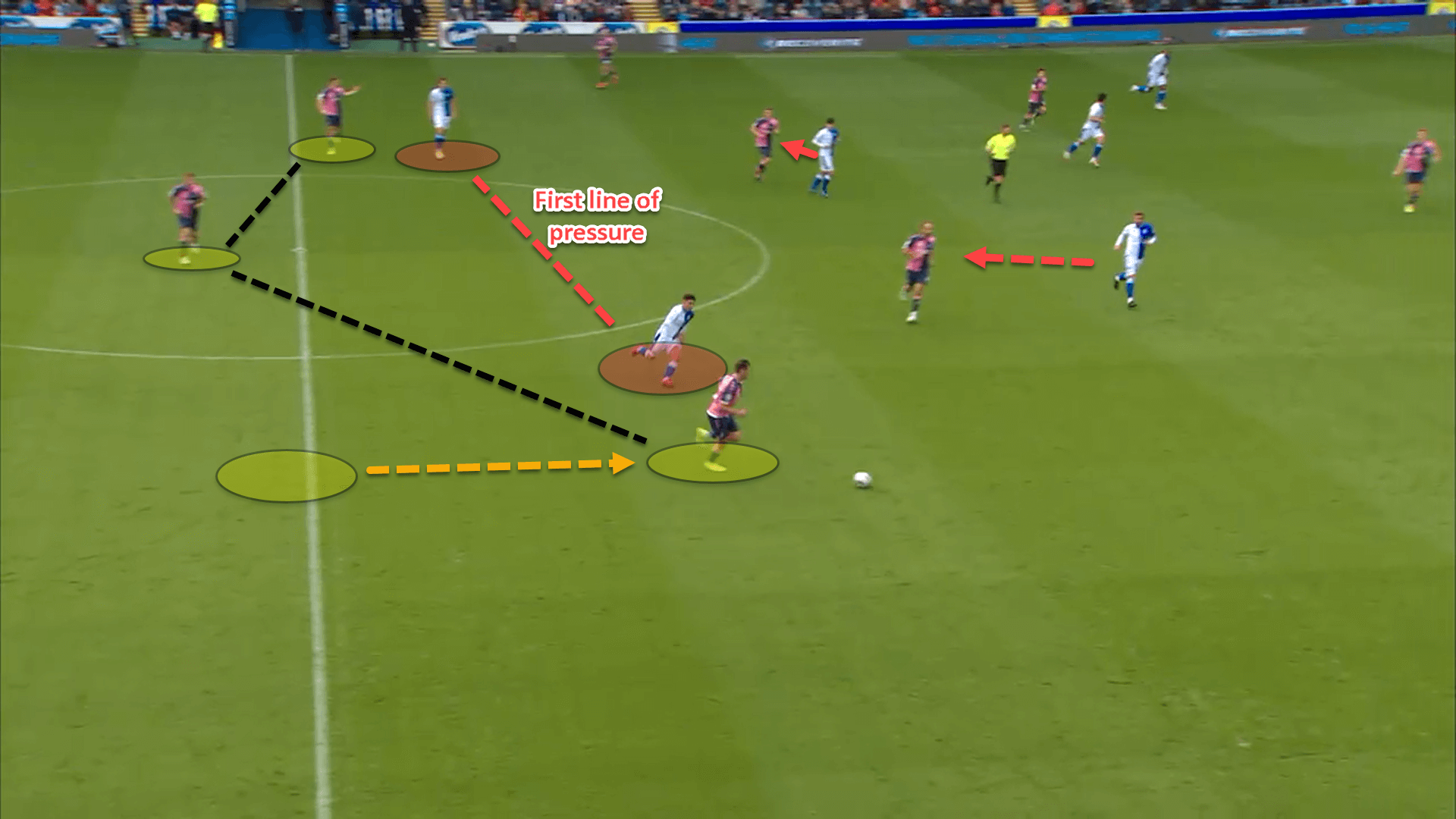
In this scenario, Coventry were struggling to break through Blackburn Rovers’ first line of pressure and so Hyam decided to dribble his way through it instead of looking for a forward passing option.
Dribbling through a press is one of the riskiest but best ways of breaking through the first line of a defensive block or a high press when the ball-carrier has decent dribbling skills. Hyam certainly does and allows Coventry to have an extra progressive option out from the back.
When he advances through the opposition’s first line, and potentially their second defensive line, Hyam stays forward and creates a wide overload.
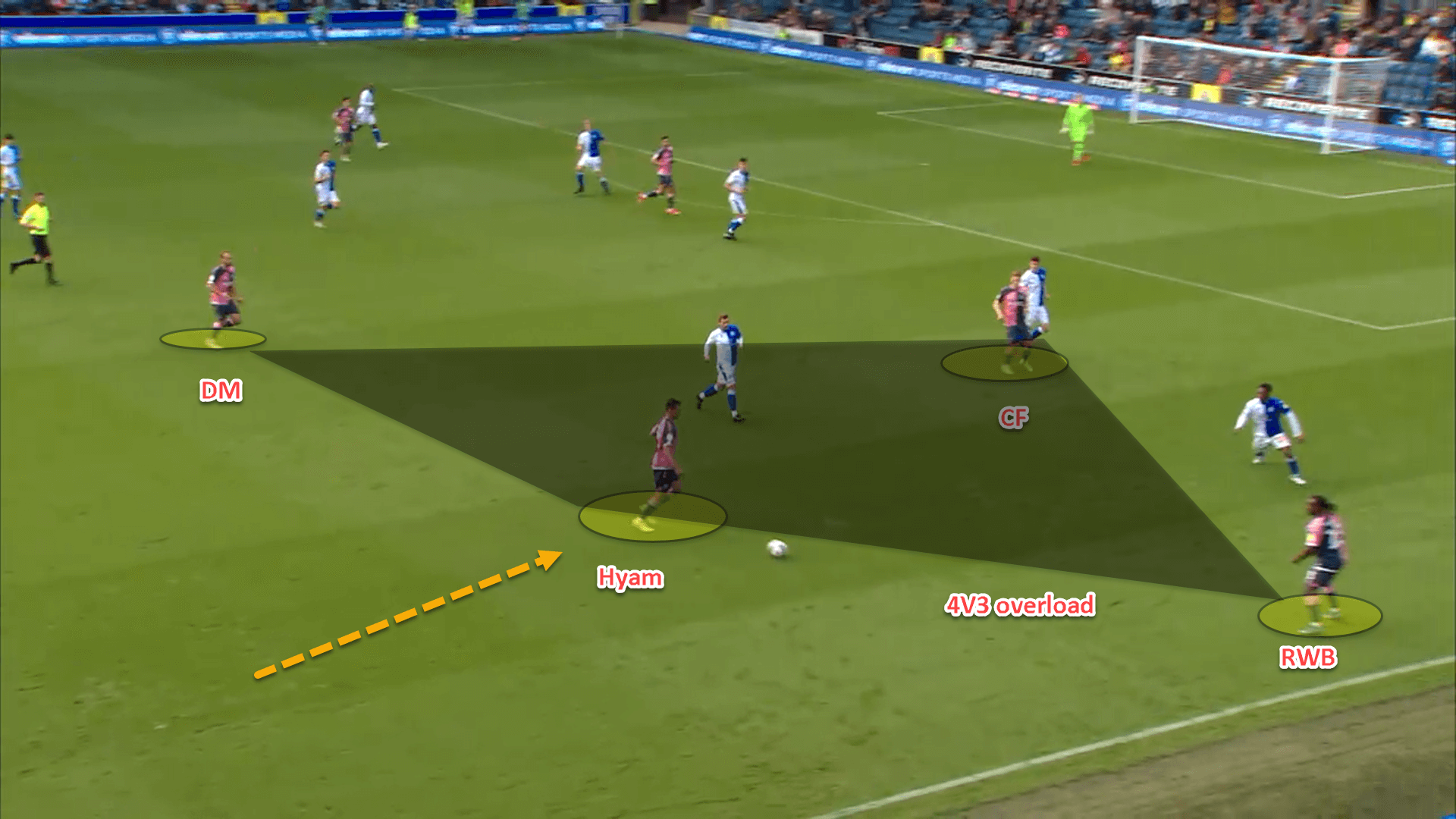
From here, Coventry can take advantage of the extra man in this area and try and break through the opponent’s backline down the flank, or else they will look to play to the feet of one of the centre-forwards between the lines as the defending team’s defensive block will be disrupted.
In the following image, Hyam advancing forward has disrupted Blackburn’s marking scheme in their 5-3-2 defensive shape which has caused a lot of room to open up for one of the centre-forwards to drop between the lines and receive to feet.
This suits the strikers as Robins prefers more physical number ‘9s’ with the ability to hold up possession and link others into the game.
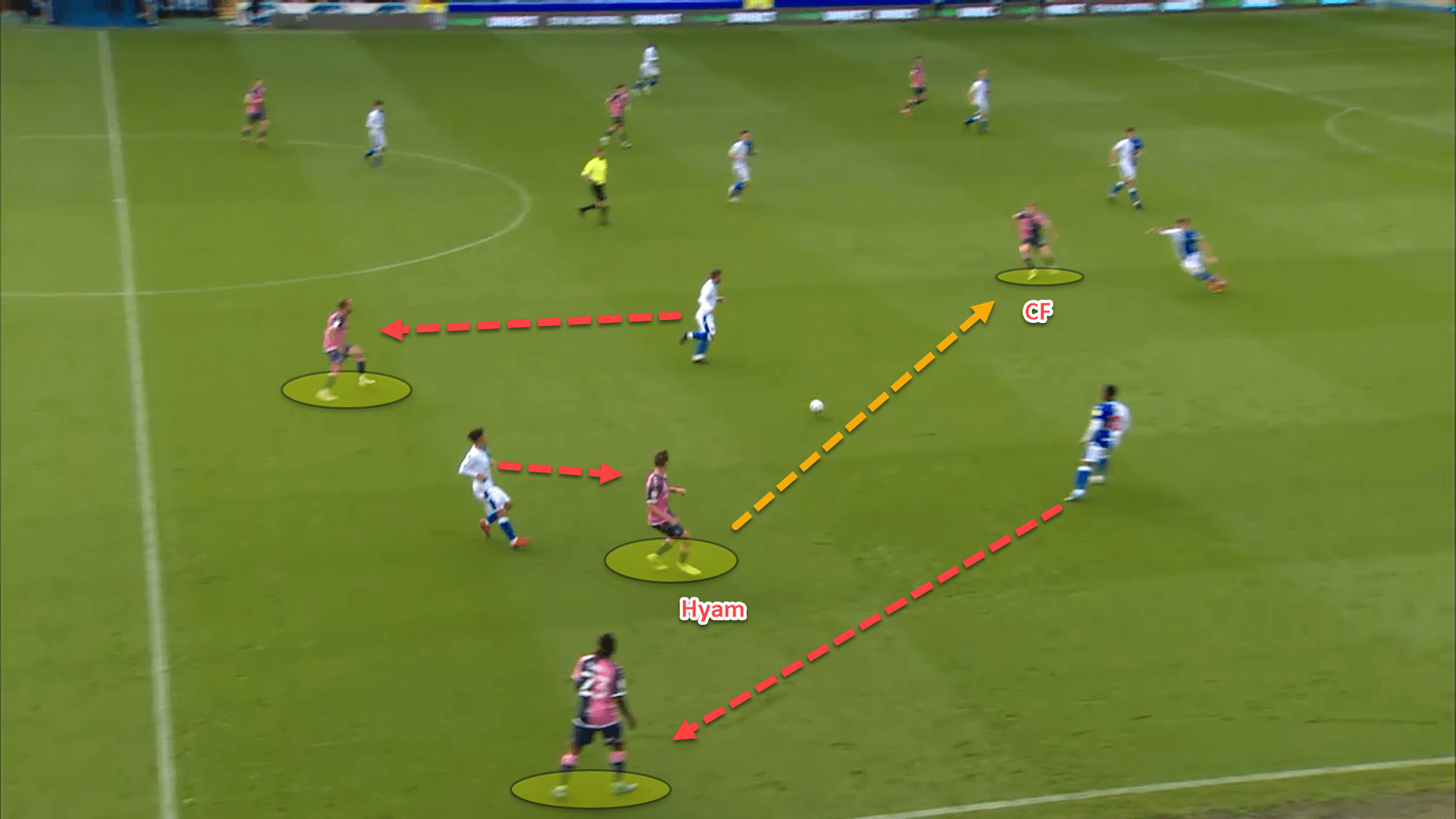
However, as stated previously, where applicable Coventry’s centre-backs will try and play to the feet of a player between the lines, bypassing their double-pivot.
The two defensive midfielders can be seen as pawns in a game of chess as in the attacking phases, the pair are often used as a gateway to reach the more technical attacking players.
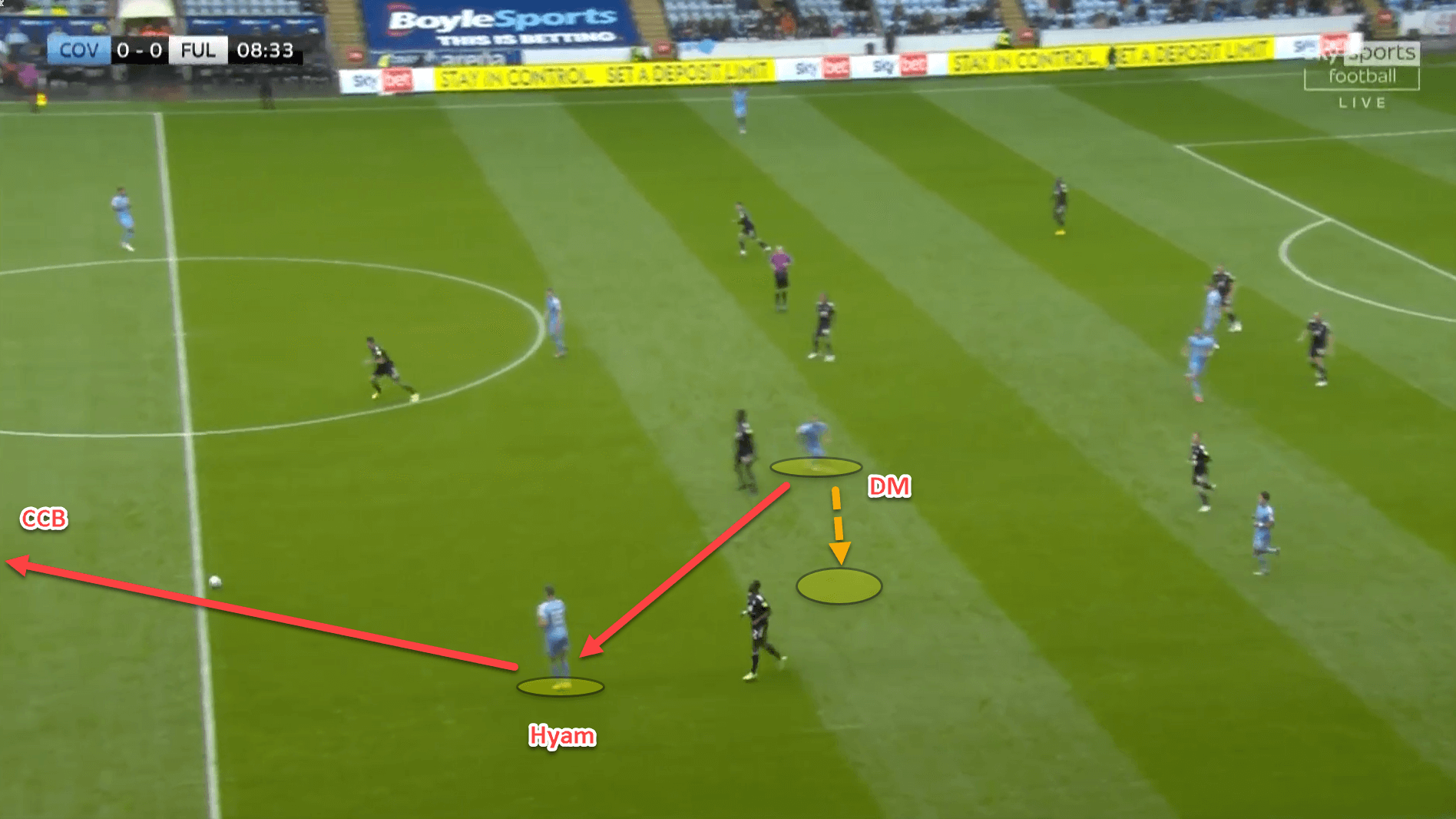
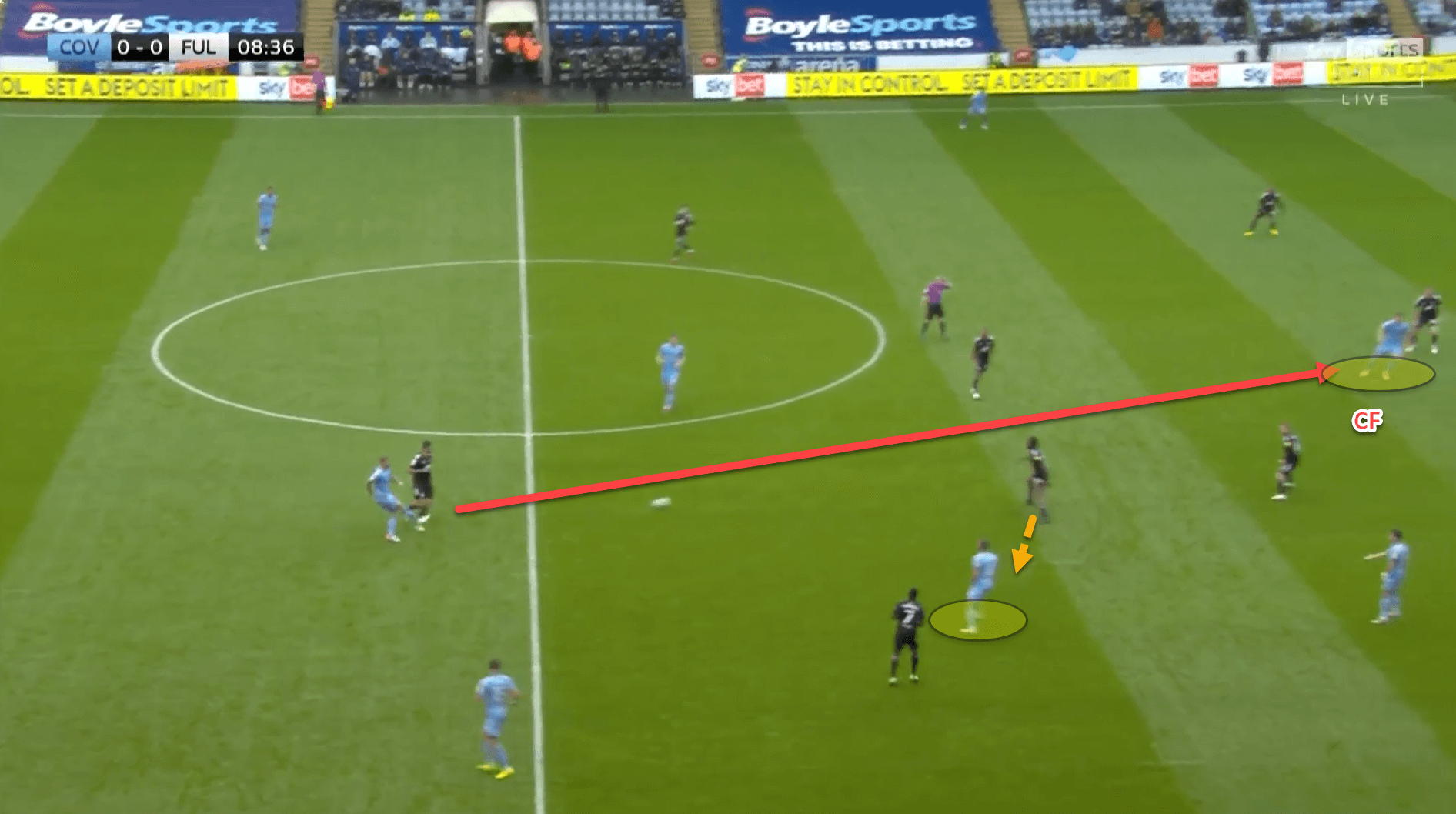
In these two images, the defensive midfielder from Coventry, Kelly, has made a one-touch pass to Hyam and quickly darts into another position to receive with his back turned to goal. By doing so, the nearest midfielder from Fulham pushes across in order to be ready in case Kelly does receive the ball.
However, this opens up a gap through the centre of Fulham’s medium-level block that Coventry can take advantage of by playing to the feet of the dropped centre-forward. The striker holds up the ball, allows the defender to close him down from behind, quickly turns him and plays to the left-wingback in a dangerous position.
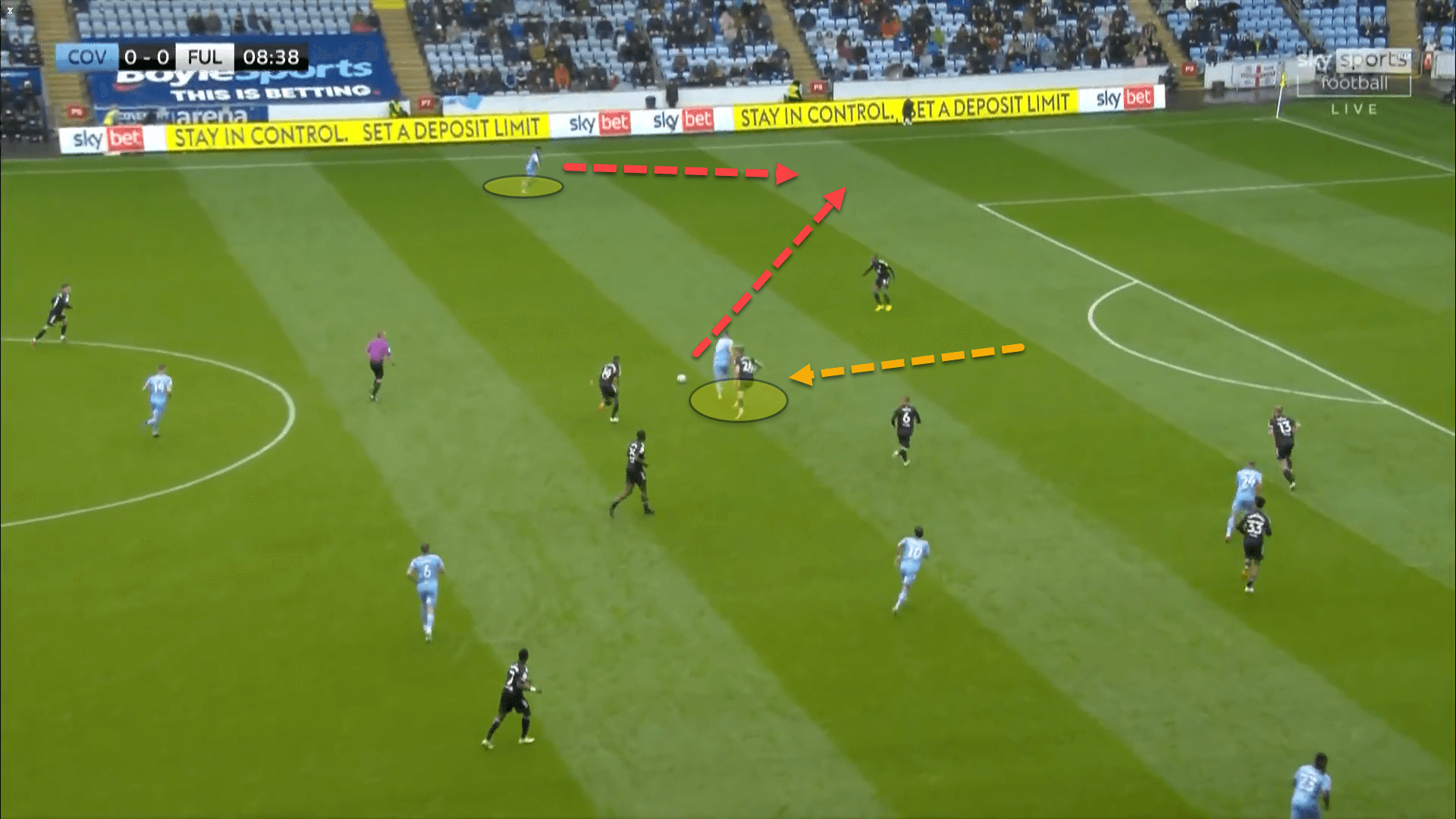
This is a really efficient way that Coventry break down an opponent’s defensive block and reach the final third where they will look to put crosses into the box from dangerous positions.
O’Hare and the two centre-forwards are vital to this attacking system. While O’Hare is confident and comfortable turning on the ball in between the lines and playing forward, the strikers are excellent with their backs turned to goal before turning to play out wide and then finally darting into the area before the ball is crossed.
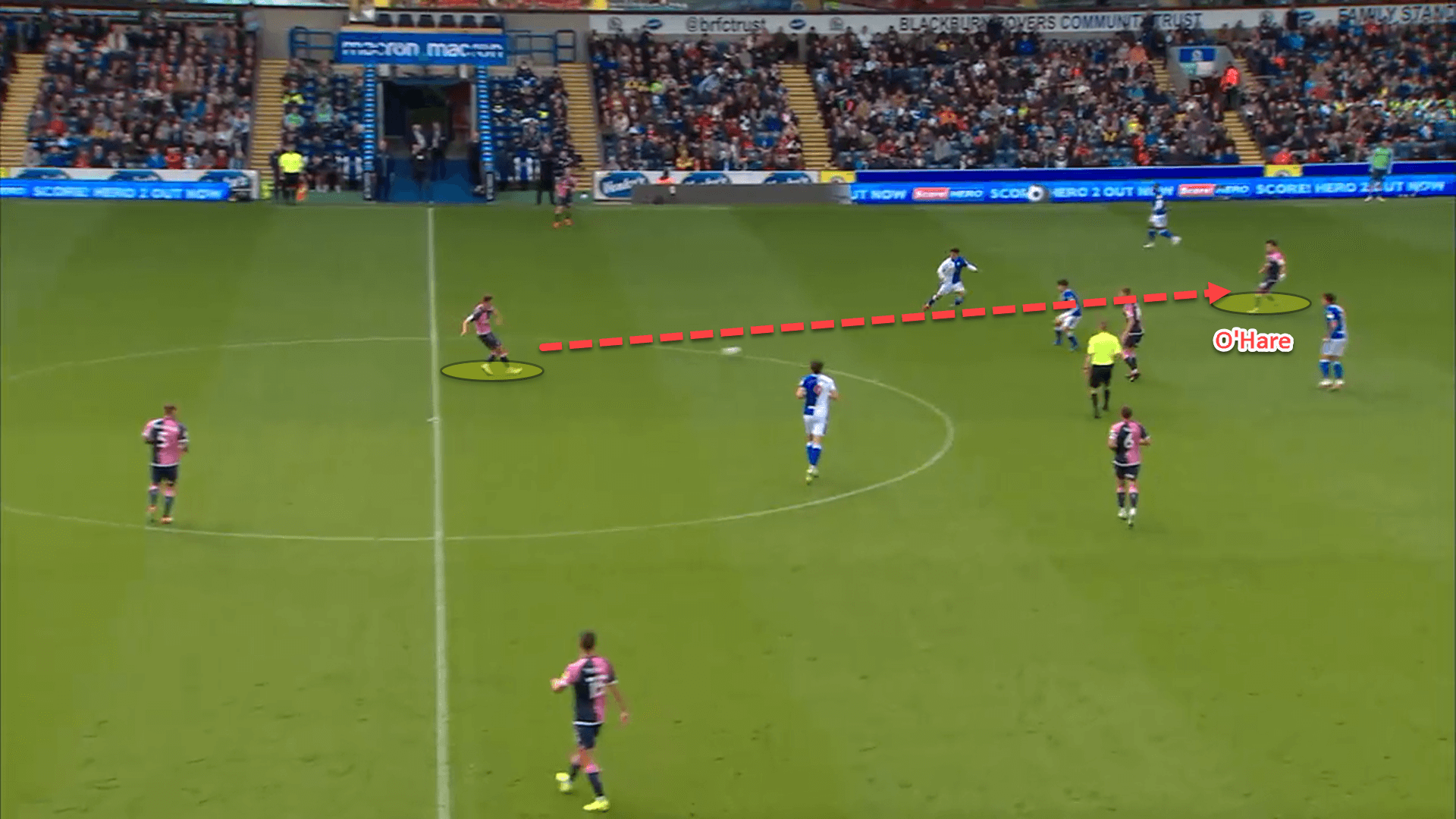
Being able to break a team down centrally is a wonderful attribute for a team to have in possession. This is because there is a much higher chance of scoring centrally through attacks then there is down the flanks.
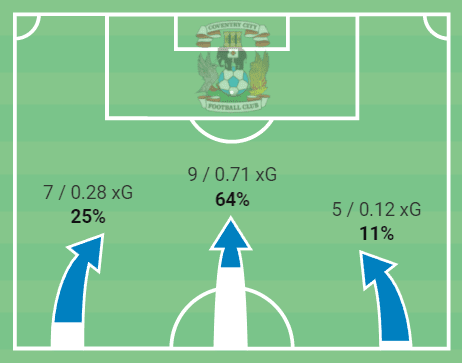
This data visualisation shows all 21 of Coventry City’s positional attacks from the Championship clash against Fulham. Nine of their 21 attacks were through the centre and it generated the highest amount of xG because central attacks are more dangerous.
Direct play and crosses
Unlike a lot of possession-oriented sides, Coventry are not hell-bent on retaining possession and trying to pass their way through an opponent’s defensive block. When the correct situation arises, the players can go direct to their centre-forwards.
By the ‘correct situation’, it means that Coventry tend not to play meaningless and hopeful long balls forward. The players will only play long if a centre-forward is making a run in behind the backline or if a switch of play is a viable option to advance play.
The two centre-forwards tend to stay very close to each other in the attacking phases as Robins wants his strikers to play off each other in a two-man partnership. Here is an example of Coventry’s pass map from a recent game against Peterborough United which also shows the average positions of each player.
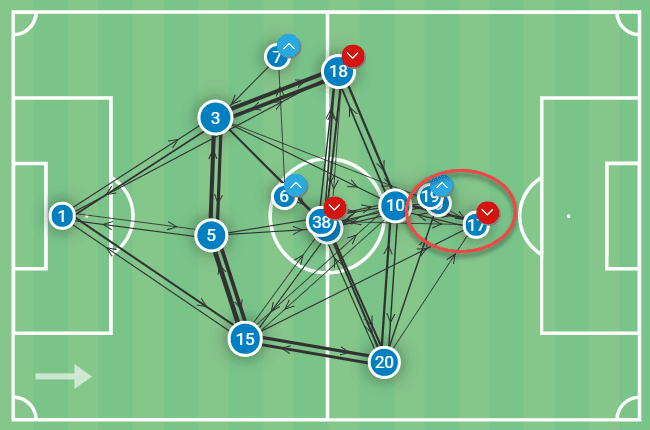
By doing this, when one player is challenging for an aerial duel, the other can make runs in behind to contest the flick-on. It also allows for good link-up play between the two.
Usually, when one drops deep, whether to challenge in the air or receive to feet, the other will make a run in behind that the ball-receiving forward can use to try and set them through on goal.
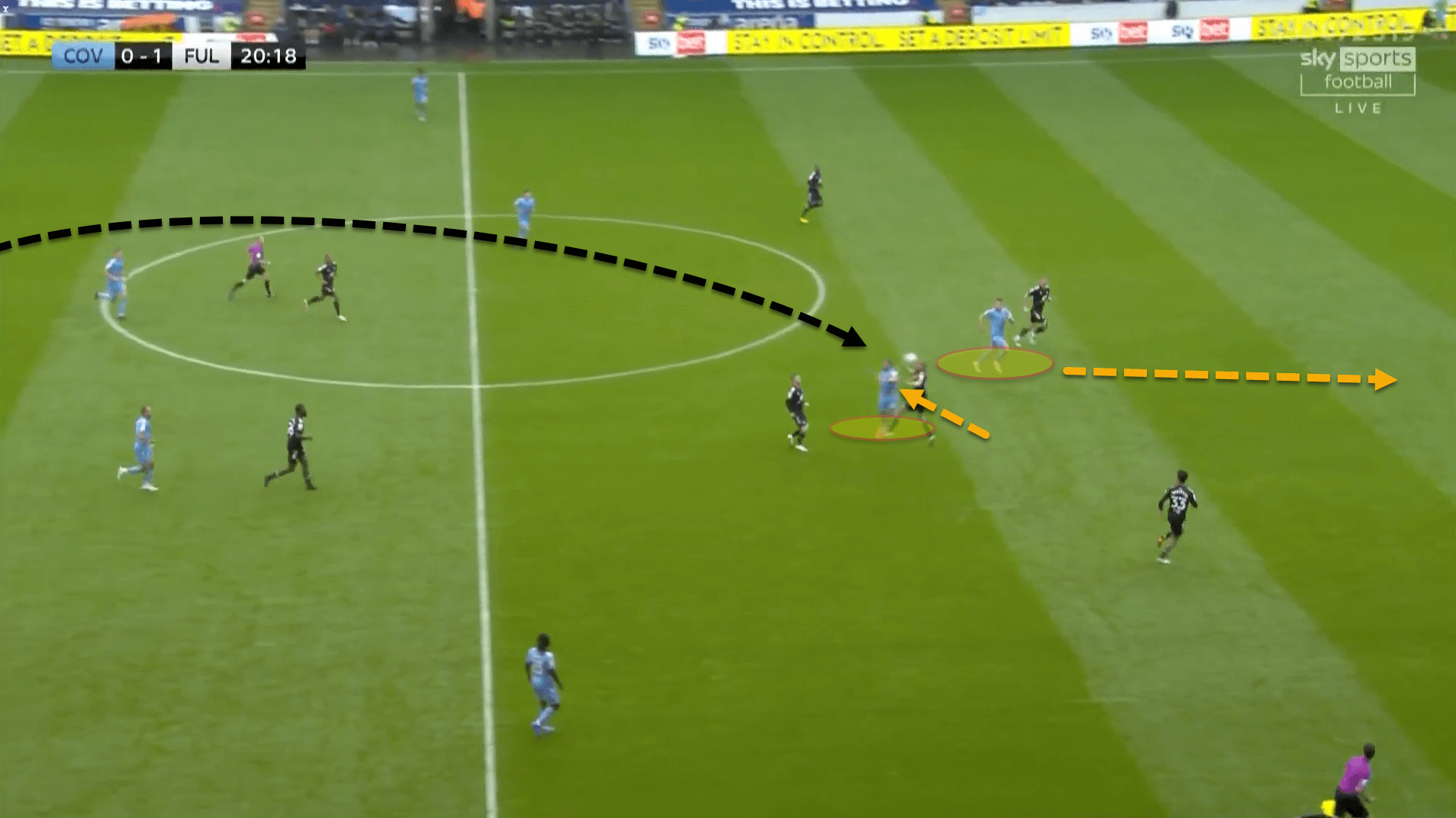
Coventry are currently averaging 43.63 long balls per 90 and have the second-highest accuracy in the league with 55.9 percent, second only to Middlesbrough.
Looking at the most recent game against Blackburn Rovers, Coventry attempted 68 progressive passes. The most used progressive passes were direct balls from the goalkeeper and both of the wide centre-backs to the two strikers from the Sky Blue.
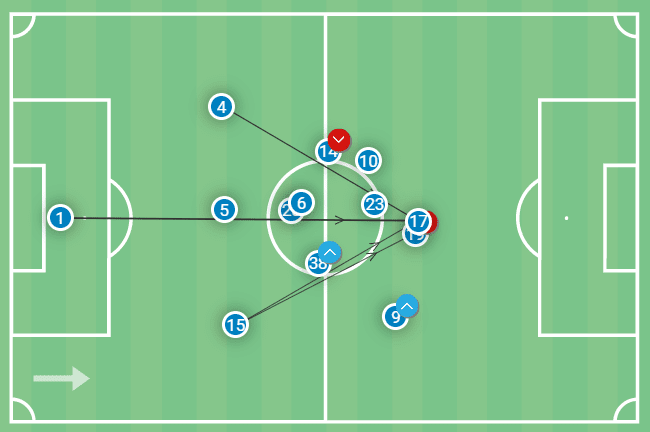
Having the ability to be able to reach the final third with line-breaking passes as well as long balls to the centre-forwards makes Coventry multi-dimensional in their play which is a very useful tool for the Championship side.
When they reach the final third, the objective is to put crosses into the box. Coventry are averaging 14.87 crosses per 90 which is the ninth-highest in the league out of 24 teams. Quite often the crosses are played from deep in the final third or else in the zones beside the six-yard box within the penalty area – also known as the assist zones.
The following image depicts all 13 of Coventry’s crosses in a recent match against Fulham and the areas of the pitch that these balls were played from.
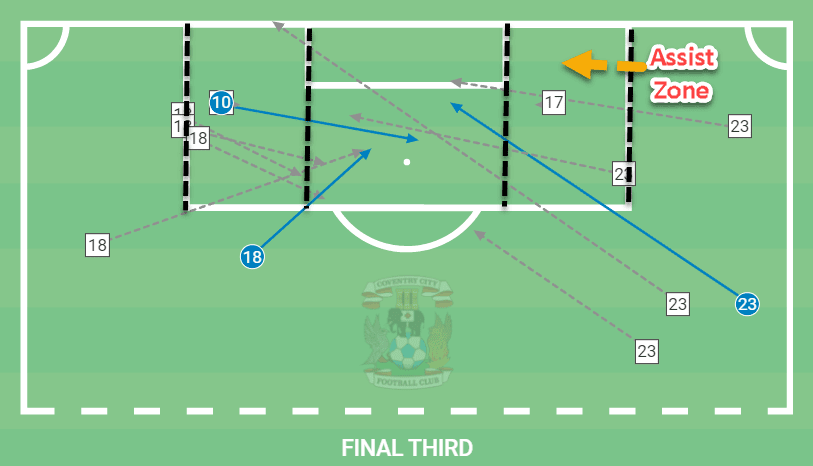
Crossing is a useful tool for the Sky Blues because, as stated numerous times, they tend to play rather physical centre-forwards up top. However, the main issue that needs to be rectified is the accuracy of these crosses.
Coventry currently have the second-lowest crossing accuracy in the Championship with 26.7 percent. They have also only managed to play 2 balls to the six-yard box per 90. This is the area in the box where players have the highest chance of scoring. Better accuracy and more balls to the six-yard box give the centre-forwards a higher chance of scoring goals.
That being said, Robins’ side have boasted an xG of 20.73 so far this season in the league which is the third-highest and have scored 18 goals in total so their goalscoring record is very solid and certainly not a pressing concern for the manager.
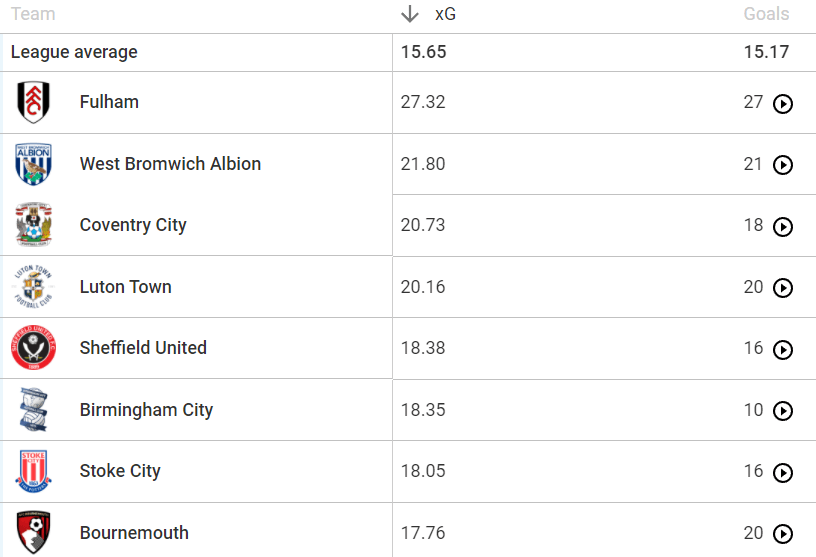
Defensive phases and counterattacking
Coventry are very active in the defensive phases, constantly looking to deny space in the central areas. The Sky Blues have boasted a Passes allowed Per Defensive Action (PPDA) so far this season in the league of 9.28 which is one of the lowest in England’s second-tier.
They also have a challenge intensity per game of 7.1. Challenge intensity calculates the defensive duels, tackles, and interceptions per minute of opponent possession that a team makes, which proves Coventry’s activity in these phases.
When pressing high, Robins sets his team up in a 5-2-1-2. The two centre-forwards press the opposition’s central defenders while the number ‘10’, generally O’Hare, marks the opponent’s single-pivot or nearest player in a double-pivot.
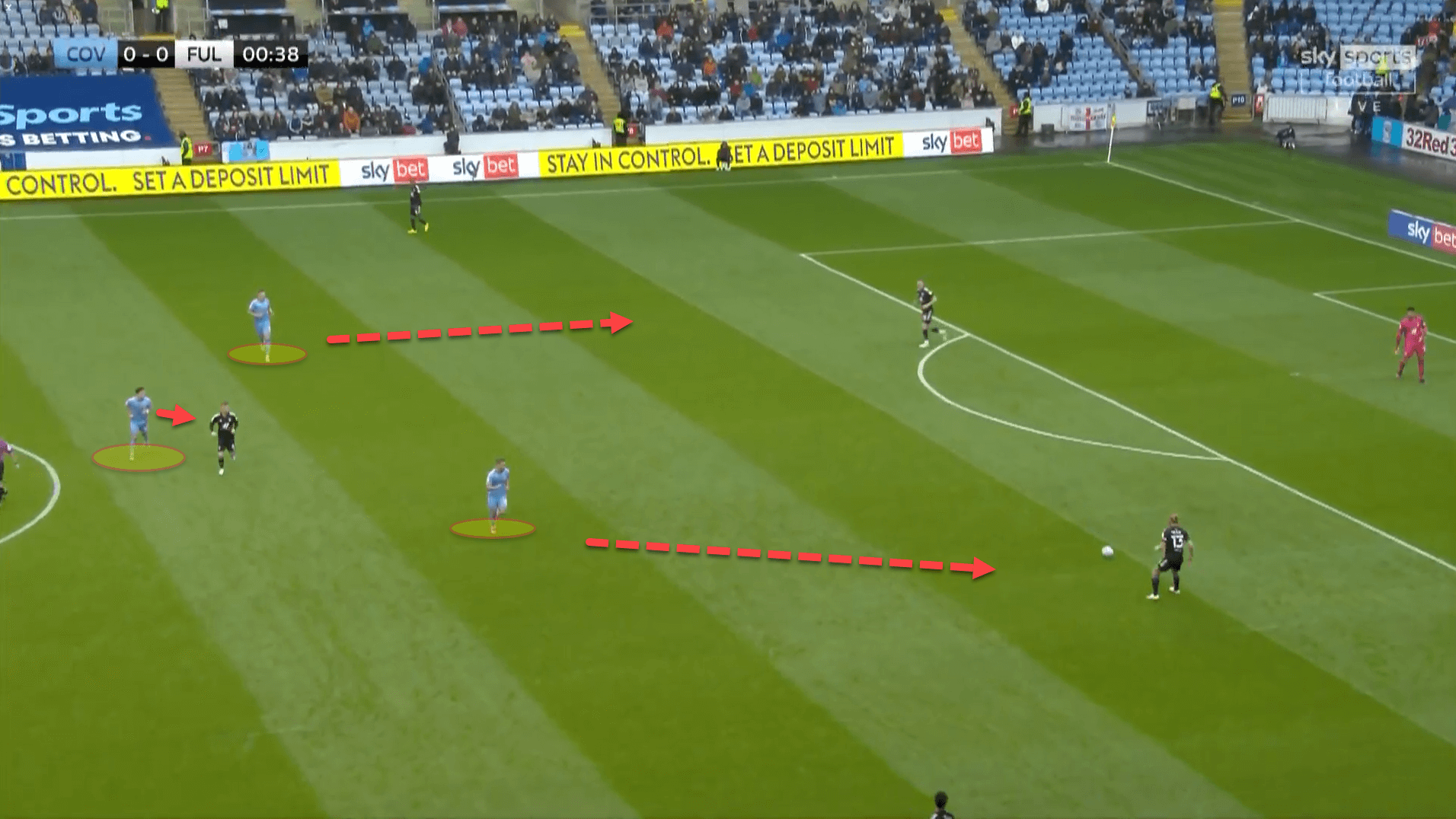
While pressing high, Coventry’s first line of pressure does tend to stand off the centre-backs when they have possession of the ball and stay rather compact alongside the attacking midfielder. This is to ensure that the first line is not easily broken, as can be seen in the image above.
In certain matches, the opposition will use two pivot players. When this occurs, one of Coventry’s defensive midfielders will push higher to mark them in the man-oriented pressing system, with the shape briefly resembling a 5-1-2-2
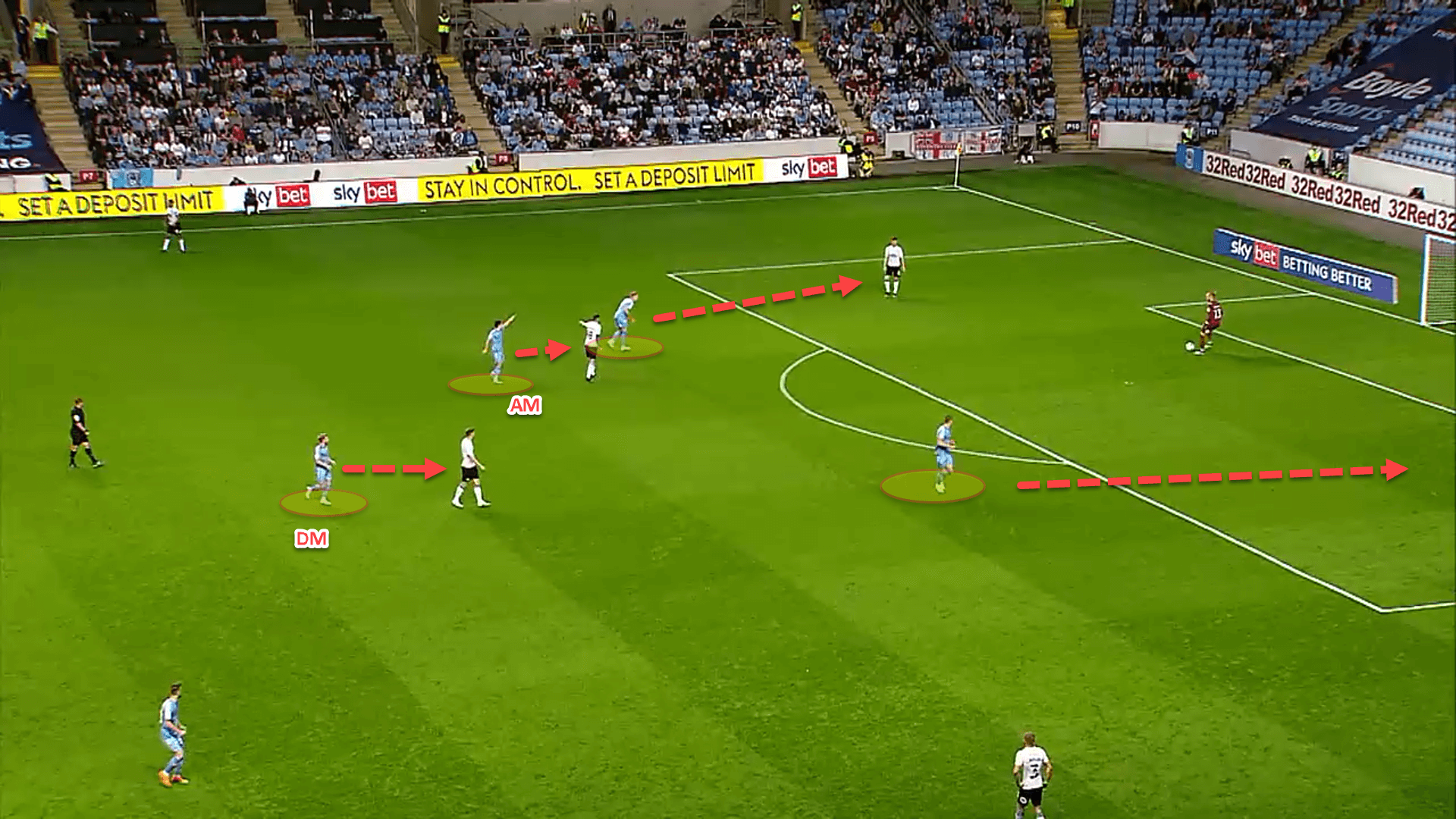
The first line of pressure’s job is to block passing lanes in behind them by applying a cover shadow when pressing and then force the centre-backs to play out wide to the fullbacks.
Forcing a team out wide is important for any side in the defensive phases because they can then use the touchline as an extra man when defending because the ball-carrier will have fewer passing angles than they would in the central areas.
When the team in possession do play out wide, the centre-forwards continue their press and apply pressure to the fullbacks while cutting off the inside passing lanes.
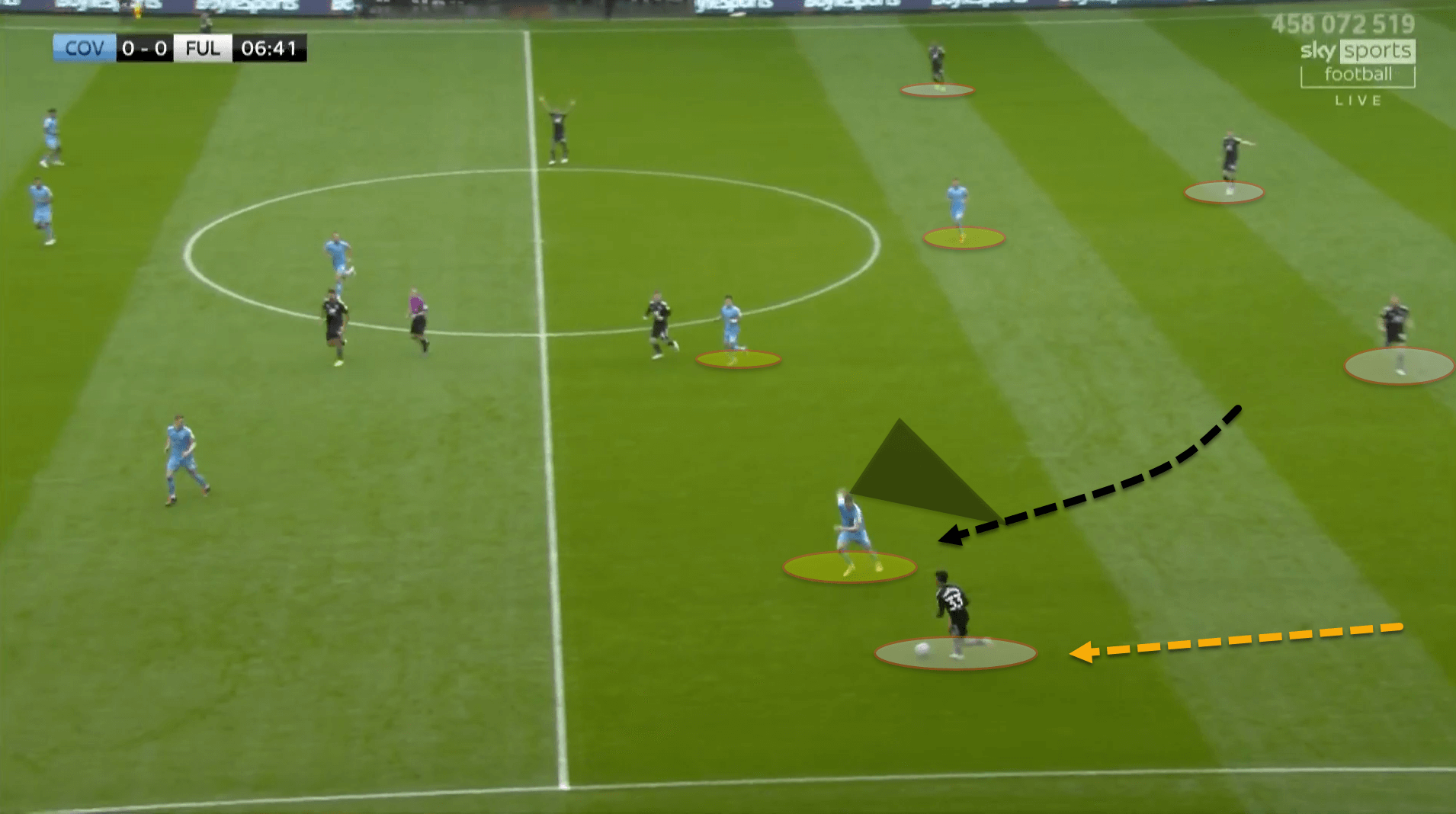
Unlike a lot of teams that press in a 5-2-1-2 and drop into a 5-3-2 in the mid-to-low block phase, Coventry maintain their 5-2-1-2 shape even in deeper areas of the pitch unless they are playing more of a 5-3-2 anyway.
This means that the double-pivot have to work extremely hard to cover spaces in the central areas but also come across to the flanks to help too.
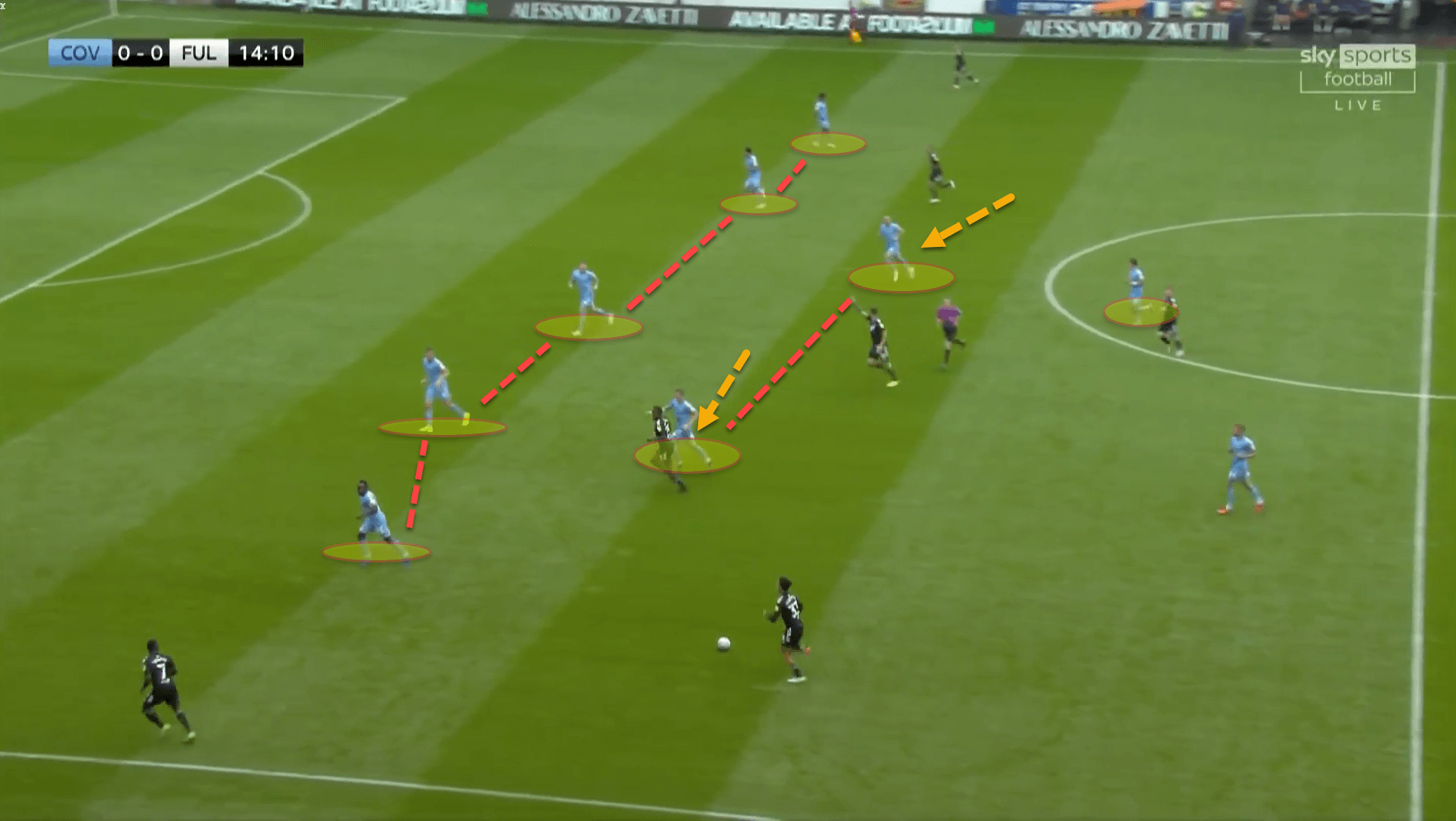
In this example, Coventry are dropping deeper into their 5-2-1-2 deep defensive block. Fulham have the ball over on the left flank and are advancing forward so Coventry’s double-pivot have to shuttle across and close down the nearest passing options.
If the ball is switched, they will then be tasked with shifting over to the opposite side to do the same. This is very tiresome, and Robins needs workhorses in the centre of the pitch but has trust in his personnel in the midfield department to do the job well.
Often, the number 10 is tasked with coming deep too but this is to mark the opposition’s pivot player, which can be seen in the previous image as O’Hare comes back to mark Harrison Reed and cut off any ball supply into him.
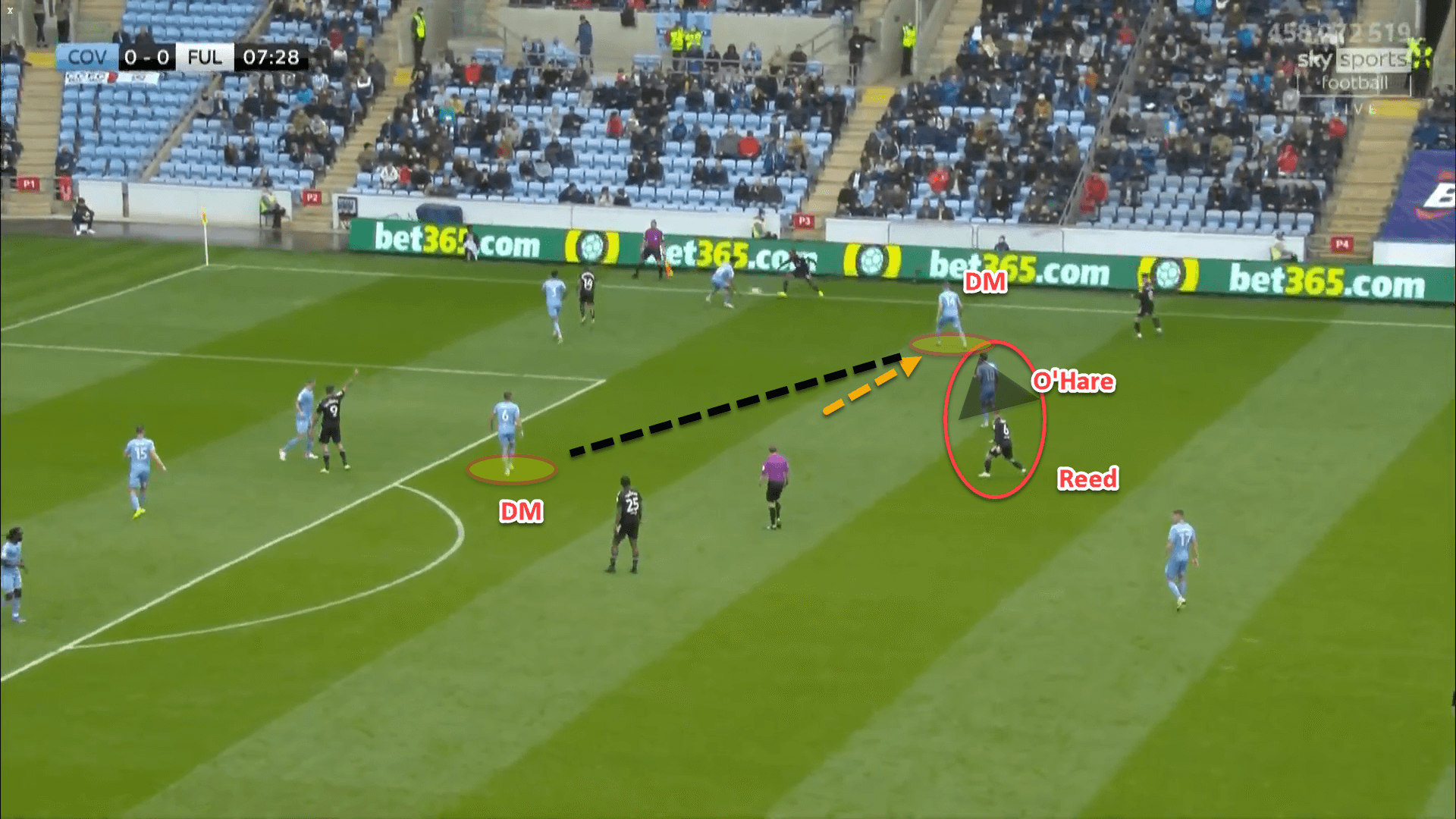
The reason for this is because a team’s midfield pivot is generally the player that positions himself under the ball and switches the play from one side to the other when they are trying to break down a defensive block.
By preventing ball supply into the pivot, the defending team are stopping this from happening which increases their chances of regaining possession.
Coventry’s double-pivot cannot perform this role because they are occupied with closing space in front of the backline while the centre-forwards are positioned higher to act as the out-ball when possession is regained. This leaves O’Hare as the best-placed player to sit on the opponent’s midfield pivot in the low block phase.
As already stated, the Sky Blues’ objective is to force the team in possession to attack down the flanks where Robins’ side can use the touchline as an extra defender. Coventry are very difficult to break down centrally and the majority of their defensive duels are out in the wide areas.
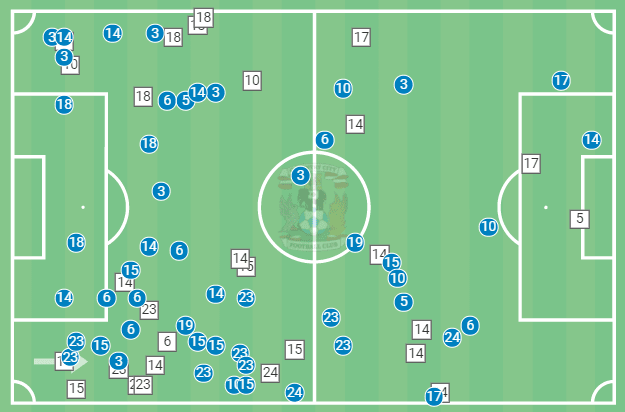
Here are all of Coventry’s defensive duels from their recent 4-1 thrashing of promotion-favourites Fulham. In this data visualisation, the blue markers signal a successful defensive duel while the white is, of course, an unsuccessful duel.
The two important to draw from this data visual is just how solid Coventry were in their defensive duels and the fact that the vast majority were out wide, particularly down their right defensive flank.
No team averages more defensive duels per 90 in England’s second-tier than Coventry City with 72.15. They also possess a 63.4 percent accuracy in these defensive duels which is one of the highest in the Championship so far this season.
It must also be noted on the side that Coventry have an xGA of 14.63 in the league and have conceded 14 goals, so they are performing pretty well on this front.
When the Sky Blues win possession of the ball, they counterattack very directly. The first thought is to get the ball to the centre-forwards either in behind the backline or else to their feet in order to allow them to link up with runners to set themselves through on goal.
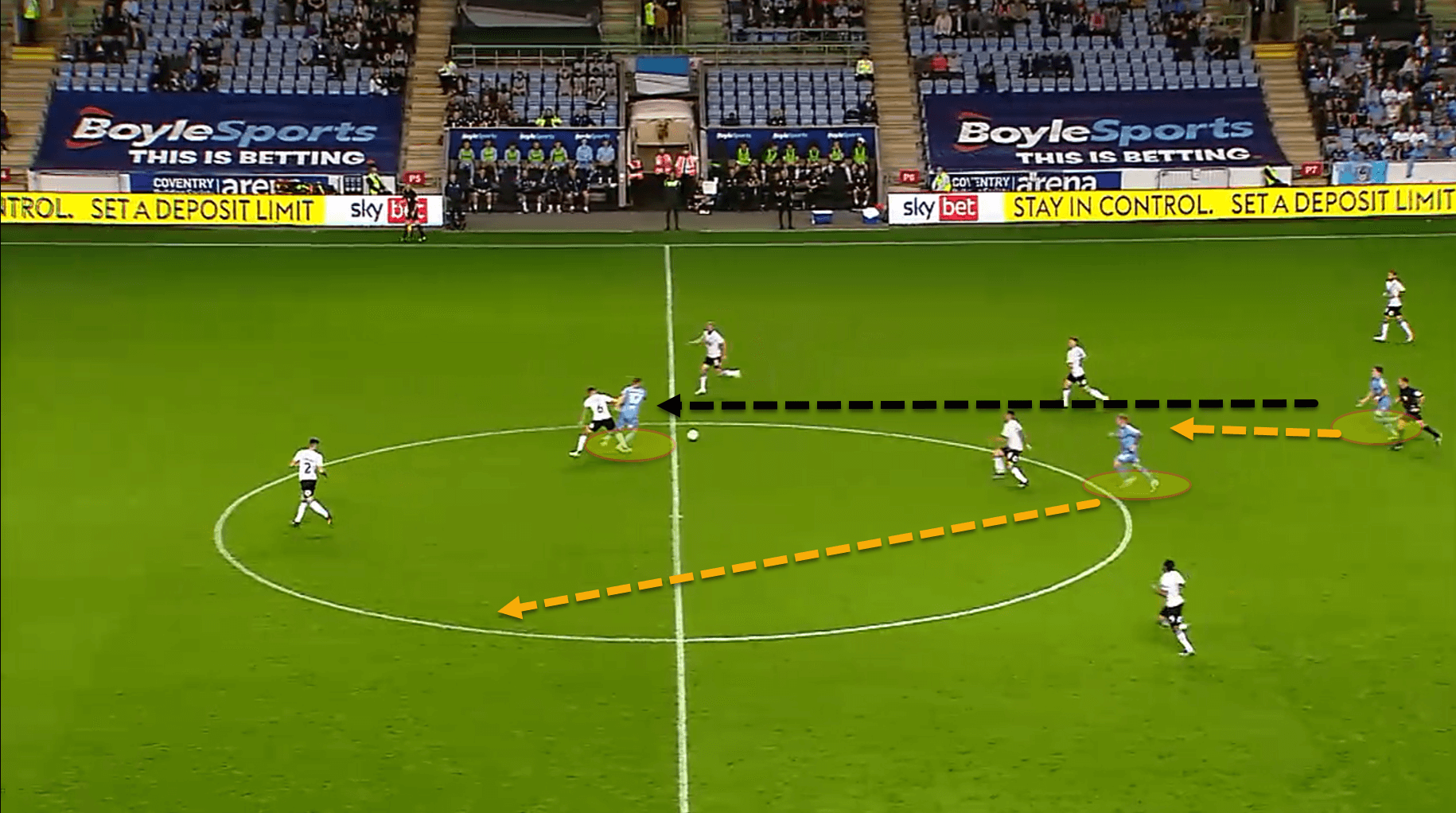
As the number ‘10’ and two centre-forwards are the furthest players forward, the trio tend to be the ones that are the most heavily involved in the counterattacks.
When the situation to transition from defence to attack arises, the strikers tend to split wide in order to stretch the opposition’s backline. This forces the defending team’s defensive line to widen, and it creates gaps for other runners to exploit. It also allows the forwards to isolate the defenders in 1v1 situations.
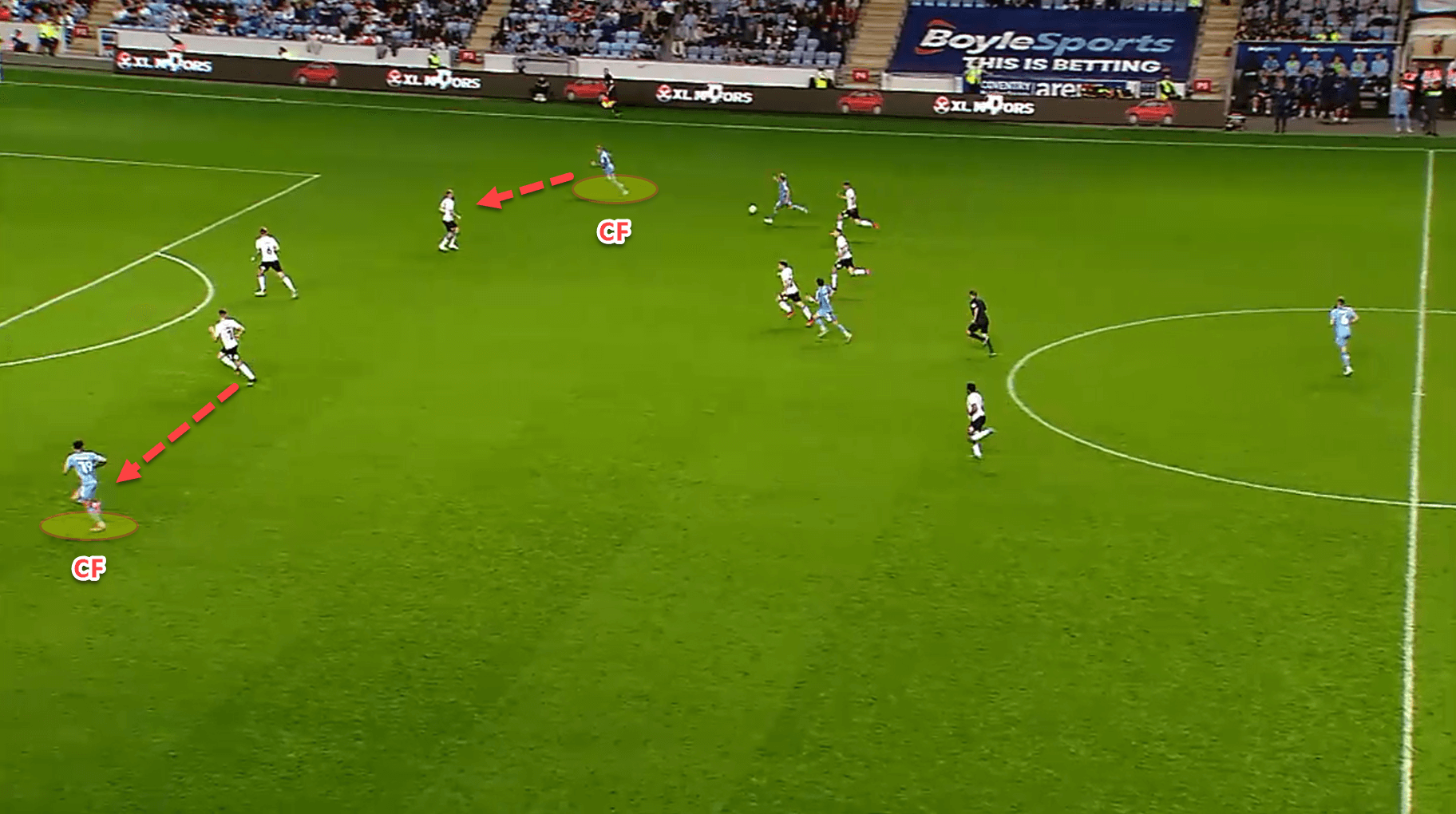
This season, in the Championship, Coventry are averaging 4.83 counterattacks per 90 which is one of the highest in the league. 37.9 percent produce a shot on goal. Comparing this to the league’s average of 1.33 counterattacks per 90, it is quite an extraordinary tally for a side that still maintains around 51 percent ball possession per game.
Being efficient in their attacking transitions means that the opposition is constantly wary of their danger in this phase of the game, and this may discourage them from committing so many bodies forward.
Conclusion
Analytically, it is no fluke that Coventry City are up around the play-off places in the Championship. They are performing quite well in a lot of metrics and are set up in a tactical system by Mark Robins which allows the personnel to flourish.
While there may be a drop-off eventually as the squad wears thin in the meat of the season, the supporters should be extremely happy with the progress made so far by the Sky Blues and the brand of football on display at the Coventry Building Society Arena.
Here’s hoping that Coventry’s excellent form can continue and provide them with enough points to earn a play-off place come May.






Comments